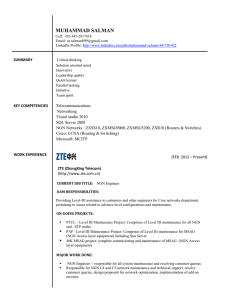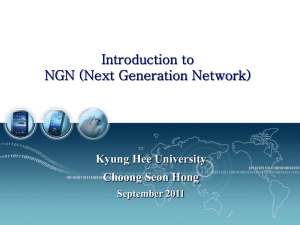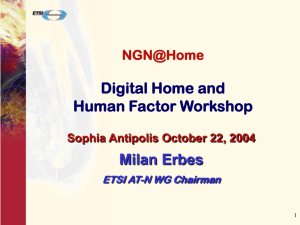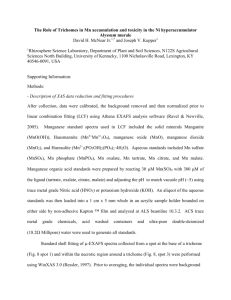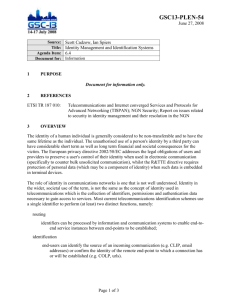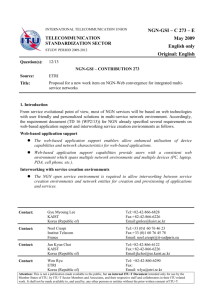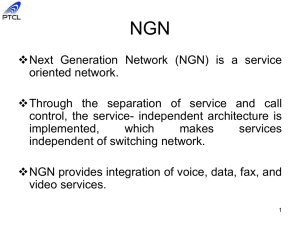Presentation
advertisement
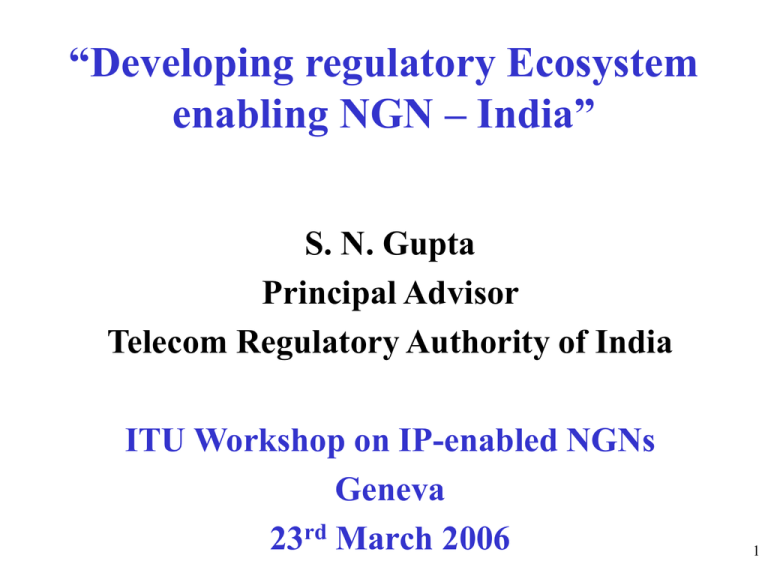
“Developing regulatory Ecosystem enabling NGN – India” S. N. Gupta Principal Advisor Telecom Regulatory Authority of India ITU Workshop on IP-enabled NGNs Geneva 23rd March 2006 1 Content • Broad ICT scenario – India • Existing licensing regime -Salient features • NGN in India – SWOT analysis of present network and framework • Regulatory Challenges for NGN • TRAI’s consultation process – Assessing the views of major players – Findings from public consultation • Way forward – Approach of a major operator – Unified Licensing – Recommendations and Decisions of TRAI • Awareness Building • • • • Enabling Policy and Licensing Framework Technical & Standardisation Initiatives Regulatory Initiatives Cross Industry collaboration (NGN eCo) 2 Broad ICT Statistics-India (February 2006) 1) Population- 1.09 billion 2) Fixed Teledensity – 4.5 (49.5 million nos.) 3) Mobile Teledensity – 7.8 (85 million nos.) 4) Overall Teledensity- 12.3 (134.3 million nos.) 5) Internet Connections- 7 million (21 million users @ 3 users per connection) 6) No. of PCs- 16 million 7) No. of TVs- 100 million 8) No. of Cable TV Connections- 62 million 9) International Connectivity- 360 Gbps/16.7Tbps (Designed) 10) National connectivity- 10 Gbps (6.7 Lakh Kms) 11) Broadband Connection (>=256 Kbps) – 10.5 lakhs 12) International Gateways by ISPs- 25 ( Including 5 on Submarine cables) India – Projections for 2010 Nos. by end 2010 Additions in next 4 years 1) Mobile – 350 million 250 million 2) Fixed – 100 million 50 million 3) Internet – 40 million 33 million 4) Broadband – 20 million 19 million 5) PC – 75 million 60 million 6) Cable TV Homes – 150 million 90 million 7) Gross Tele-density – 40 8) Rural Tele-density – 10 30% 8% 4 Widening gap between urban and rural tele-density 35 35 30 20.79 20 15 14.32 10.37 10 5 Urban Rural 26.2 25 5.78 0.43 0 1998 6.87 0.52 1999 12.2 8.23 0.68 2000 0.93 2001 1.21 2002 1.49 2003 1.55 2004 1.74 2005 2 2006 Urban Rural divide is increasing very fast primarily due to negligible mobile coverage in rural areas and policies must ensure rural tele-density increase Would only be possible when rural growth is mobile and competition driven, like in urban areas At present, there is negligible rural mobile coverage and the growth is PSU/ USO driven. Unless it is competition driven, growth will continue to be stagnant 5 Institutional Framework for the Indian Telecommunication Act/ Legislation Making Policy Making Parliament of India Recommendations Govt. of India (Ministry for Licensing of Communications &IT) Regulation (Tariff, Interconnection, QOS) Spectrum Wireless Planning Management & Coordination Wing (WPC) Standardization & Technical Inspection Telecom Engineering Centre (TEC) Type Approvals Equipment Supply TDSAT TRAI Manufacturers and System Integrators DOT/ Telecom Commission Dispute Resolution & Appeal for DOT & TRAI Directives Executive and Licensing Centre for Development of Telematics (C-DOT) Operators Telecom R&D Service Provision Subscribers End Usage i) Categories of Telecom Licenses Access Providers (APs) ----- (Access to Customer/ Local Service) - Fixed Service Providers/ Basic Service Operators (BSO) Combined as Unified Access - Cellular Mobile Service Providers (CMSP) Service (UAS) since Oct’03 - Internet Service Providers (ISP) - Cable TV Operators (CaTVO) ii) Long Distance Operators -----(Long Distance telecommunication) - National Long Distance Operators (NLDO) - International Long Distance Operators (ILDO) iii) Infrastructure Providers ------(Infrastructure to the Licensed Telecom Service Providers) - Infrastructure Provider Category –I (IP-I) To migrate to NLDO - Infrastructure Provider Category –II (IP-II) iv) Value Added Service Providers -(Other than Access & Long Distance Services) - Public Mobile Radio Trunking Service Providers (PMRTS) - Paging Service Providers (PgSP) - VSAT Service Providers (VSATSP) - Voice Mail/ Unified Messaging Service Providers (VMSP/ UMSP) v) Other Service Providers (OSP) -----(Other than all above, Non-facility based Operators) - ITES, Call Centres - CUG (Closed User Group) - Emergency Communication Services - Tele-medicine, Tele-health, Tele-education etc. vi) Broadcast Services - Radio & TV Broadcast (FM, Terrestrial TV etc.) - DTH - Cable TV 7 Service specific licensing in India Type of Service Service Area Connectivity with PSTN Entry Fee Annual License Fee (% revenue share) ILD International Full PSTN/PLMN Interconnection Rs.25 million 6% NLD National -do- Rs. 100 crore 6% Unified Access (Fixed and Mobile) (UASP) Circle -do- Different for each Circle (Based on Bidding) Global Mobile Communication by Satellite International -do- Rs. 1 crore 6% VSAT National No Interconnection Rs. 30 Lakhs 6% Radio Paging Service Providers City wise and Circle wise One Way Interconnection with PSTN Internet Service Providers National, Circle wise, SSA wise -do- Public Mobile Radio Trunked Service City wise and Circle wise Infrastructure Providers Cat I National Infrastructure Providers Cat II National Type A - 10% Type B - 8% Type C - 6% 5% Nil Rs. 1 (6% for Internet Telephony) Nil 5% NA Nil Nil Full PSTN/PLMN Interconnection Nil 6% Limited way One 8 Promoting Competition in Phases 0 Fixed Mobile Monopoly 1 Duopoly 2 3-4 operators 3 4 Value Added Services (VAS) Unified Access Duopoly in Access, Monopoly in Long distance Nation wide Duopoly Monopoly in Access, competition in Long distance Open competition Unrestricted entry in all segments e.g. India Unified Licensing/ Authorization (de-licensing) Single license for all telecom services and class license (authorization) for all value added services 9 Liberalized Licensing and Regulation for Broadband Same as Internet Service Providers’ (ISP) License. The most liberal licensing regime. Unlimited competition (180 ISPs operational, 388 Licenses signed). No entry fee. No license (revenue share) fee. Annual Fee of Re. 1 only (6% for Internet Telephony) No contribution to Universal Service Fund (USF). Permitted to have own international gateway through sub-marine optical fiber cable or satellite. FDI limit (100% for non-gateway service provider, 74% for International gateway service provider). Permitted to make use of BSO’s Dialup Network, Cable TV’s Network, own Copper, Fiber, Radio for last-mile connectivity. 2.4 Ghz (ISM) band de-licensed for indoor as well as outdoor usage for broadband access (5.1 to 5.3 and 5.7 to 5.8 GHz delicensed for indoor & in-campus usage). High speed WLL permitted for BSOs. A liberal V-SAT licensing policy (upto 2Mbps). Permission to use DTH setup for Internet download. 10 Salient features of existing regime • Unified Access (technology-neutral) – coexistence of GSM/ CDMA (WLL), Fixed • Very low termination rates (< 1 cent/min) (same for fixed and mobile) • Very low carriage charges (1 cent/min) • Very low mobile tariff (2 cent/min) • Very low long distance tariff (2 cent/min) • Very low ARPU (8 US$/month) • Very low Broadband charges (5 US$/month) • Low rural tele-density (< 2%) • Low mobile network coverage (< 35% of population) • Overcapacity for international bandwidth (17 Tbps/ 360 Gbps) • Wide spread national backbone (7 lakhs Km) • Dominance of wireless access (95 million subscribers vis-à-vis 40 million wirelines) • Monthly subscribers additions – 5 million • Large cable TV homes population (62 million) 11 NGN India – A SWOT Analysis –Strength of present network and framework –Weaknesses –Opportunity/ Benefits –Threats/ Risks 12 Strength of present framework and network • Open unrestricted competition in all segments (including mobile) • Access service provision unified (broadband, triple play, internet telephony permitted in addition to voice, fixed/ mobile/ WLL) • General technology-neutrality (technology option left to operators) • General tariff forbearance (Except leased lines where competition is not enough) • Broadband policy in place (Govt’s mission to accelerate access) • Access network dominated by wireless (95 million out of 135 million) • 5 million telephone additions per month • 62 million cable TV homes and 40 million wireline • Proactive regulator (initiatives on emerging issues like IP based networks, IPv6, unified licensing, convergence etc.) 13 Weaknesses • Multiple regulatory agencies - licensor (DOT), spectrum management (WPC), technical regulation (TEC), interconnection, tariff & QOS regulation (TRAI), dispute settlement (TDSAT) • Separation of licensing and regulatory functions (coordination issues) • Non-unbundling of local loop (lack of competition for DSL) • Non-engineered, unidirectional CableTV infrastructure • Legacy interconnection regime (miles and minutes based) • Low voice ARPU ( 8 USD/ month) • Value-added service providers not treated as interconnection entity • Resellers (non-facility based operators) not permitted 14 Opportunity/ Benefits • Large unmet demand for telecom services (telephony teledensity– 12%, Broadband penetration - 0.1%) • Mobile coverage only 35% (semi-greenfield environment to expand) • Rationalization of network resulting into simplicity and reduced OPEX • Network expansion by using future proof technology (NGN) • EX-ANTE regulation for NGN to remove uncertainties • Involvement of industry in various issues fully in a proactive manner • Learn from the experiences of developed countries • Be a part of NGN pioneers for the region (Asia-Pacific) • Bring triple play services to rural area (bridge digital divide) 15 Threats/ Risks • Standards and interoperability issues yet to be settled • Technical challenges in Emergency access/ Security monitoring • High CAPEX without corresponding increase in ARPU • Project oriented risks due to huge scope and costs in migration • Policy against unbundling of local loop (LLU) • Non-introduction of ‘reselling’ (non-facility based operators) 16 Driving forces for NGNs Asia Pacific Region including India – Operational cost savings, new services for increasing ARPU – Predominantly mobile users, less investment in legacy infrastructure, new services – Low tele-density and Broadband penetration – Address space limitations, – Government’s / Regulator’s NGN initiatives – Increased roll-out of new networks in the countries in economic transition Source: ASTAP05-FR10-PL-30 17 NGN Regulatory Challenges As per ITU:“The move to NGNs represents an opportunity to establish in advance ground rules for ensuring the continued passage to effective competition and minimise damage during transition”. It is in contrast to the regulation of the legacy network, which came after the networks were actually in place. That is why, NGN is different. 18 NGN Regulatory Challenges (Cont’d) Regulatory concerns (i) Death of distance and blurring of the traditional boundaries between Access (local) providers and long distance carriers. (ii) VOIP as a “disruptive technology” putting a challenge for the regulators to perform a balancing act in maintaining level playing field. (iii) On-going technological developments causing drastic impact on the telecom scenario forcing a re-look at the service based licensing and geographical area based regulatory regime including Numbering systems. (iv) Level playing field issue between the licensed telecom operators and value added service providers. (v) Need for new interconnect products based on capacity and quality (V&V) in place of those based on distance and duration (miles & minutes). (vi) Access to emergency services like police control room, fire services, medical help etc. (PSAP, E 911 (US), 999 (UK), 100 (India)) (vii) Security monitoring like legal interception & monitoring (LIM), wiretap, CLI etc. Requirements of Next Generation Licensing A converged regulator (single regulator for Telecom, IT & Broadcasting) A single technology-neutral, service-agnostic license (one license - one 19 Security Regulation of “Plain Old Telephone Service (POTS)” Numbering Interconnection Consumer protection Privacy Quality of Service Emergency Access Interconnection Competition “Next Generation” Long term issues Regulatory implications of NGN Source: ASTAP05_WS.IP&NGN-09 Core policy areas: •Competition (level-playing field), Interconnection •Consumer (QOS, privacy, emergency access) •Security & legal interception Scope for light-touch regulation20 NGN Consultation Process – India Issues for Consultation • ‘Light-touch’ v/s ‘Tight’ regulation or regulatory withdrawal (hands-off, forbearance) • Ex-ante v/s Ex-post regulation • Level-playing field issues – Service-based competition, Networkbased competition, Access competition • Regulatory incentives – standardization, transition time-table, special rate of return, alternate access paths, special concession for deployment in rural areas • QOS regulation for NGN • Interconnection regime in NGN context – interconnecting parties, interconnection products, types of interconnection, basis for charging, interconnect exchange • Mandating for emergency access – 100, 101 etc • Security aspects of NGN – Adherence to requirements for Legal Interception and Monitoring (LIM) 21 NGN Consultation Process – India Assessment of views of 7 major players S. No. Issue Response 1 Level of awareness of the benefits and the costs of Top level – 2/7 migration to NGNs within the organisation Middle level – 1/7 2 Major concerns on NGN migration Access investment - 6/7 VOIP regulation – 3/7 3 Timeframes for NGN deployment Core within 12 months –4/7 1-2 years – 2/7 2-5 years – 1/7 Access beyond 2010 – 6/7 4 Importance of implementing a ‘single access’ network 3/7 5 NGN migration dependent on allowing operators to access the incumbent’s access network (LLU) 4/7 22 NGN Consultation Process – India Assessment of views of 7 major players (Cont’d) S. No. Issue Response 6 Regulatory initiatives for regulator to consider for Cross industry body – helping the transition to Next Generation Networks 5/7 Transition left to operators – 6/7 New interconnection regime – 3/7 7 Concerns on standardisation Technology-neutral policy of regulator 8 VOIP regulation Same as PSTN – 5/7 23 NGN Consultation Process – India Findings from Public Consultation • Lack of awareness about NGN and need for training/ educational programmes • Lack of enough infrastructure for considering any service based competition • Need for a single license to provide all services (data, voice, broadcast through same network) • Need for detailed consultation on interconnection issues and QOS regulation in NGN environment • Need for accelerating the Broadband penetration for access migration • Need for deliberations on technical and standardization issues with special reference to interoperability, emergency access and legal interception and security monitoring • Need for cross-industry collaboration under the aegis of regulator to deliberate upon time table for NGN migration as well as interconnection issues 24 Major operator’s approach towards NGN Five-fold Migration Approach • Create nationwide IP-MPLS backbone network (fiberbased) (5,00,000 Km) • Create access agnostic Metro Area Networks (MAN) (subscriber access capable of convergent voice, video and data services over DSL, Optical Ethernet and Wireless technologies) • Implementation of VOIP based Class 4 services (packetize junction traffic of TAX) • Implementation of Class 5 services over packet network (subscriber services) • Offer Multimedia/ Triple play services including VOIP to Broadband subscribers 25 NGN Roadmap for a major operator PRESENT STATUS 1 2A 2B 71 city coverage (NIB-II) 0.73 million broadband lines providing High Speed Internet (233 cities) 0.5 million broadband loop carrier lines capable of triple play covering 167 cities THE ROAD AHEAD – 3 Year plan 326 LDCA regional coverage 2C 114 Kbps GSM GPRS lines (9 million) 2D 144 Kbps CDMA 2000 1X (1 million) Metro Area networks covering 5 million broadband lines capable of triple play 384 Kbps GSM Edge lines (209 cities) 2 Mbps 3G lines (20 million+/- 25%) 2 Mbps CDMA EVDO (1 million, i.e.5%) 3 Class IV Soft Switch with Media Gateway (200K lines) Class IV Soft Switch with Media Access Gateway (4000K lines) 4 Class V Soft Switch (2 million lines) being planned, specifications under preparation Class V Soft Switch for 20 million lines Data Center architecture (10 cities) Class V Soft Switch for CDMA to be attempted 5 Pilot multimedia to be planned subsequent to Soft Switch deployment Multimedia Soft Switch lines (2 million) 26 National Internet Backbone (NIB-II) IP-MPLS NETWORK CORE 24 cities EDGE 71 cities STM-16 27 National Level IP-TAX Network 200 K circuits, 8 million BHCA AS 0 Soft switch (MGC) NMS EMS SGW New Delhi AM AG RJ MG PT MG MG JLN ND JPR LW MG MG MG MG MG GU MPLS Core MG AHM MG MG KOL Existing PSTN NETWORK RPR MG MG BPL MG MG MG MBI MG NGP MG HYD CHN MG CBT MG MG BG ENK CK Chennai Soft switch (MGC) AS EMS SGW 28 Intra city & Intra SSA transport - 6 lakh Broadband customers Ethernet Service CISCOSYSTEMS Power Supply 0 Power Supply 1 Soft Switch ISP Email Hosting DNS Caching SD Catalyst 8500SERIES RAP FE Switch Processor 1 GB / STM-16 ACCESS RING CISCOSYSTEMS Power Supply 0 Power Supply 1 IP-MPLS CORE RING SD Catalyst 8500SERIES Switch Processor GE Services Hub Video CISCOSYSTEMS Power Supply 0 GE IP-MPLS Backbone Local POP VOD & Content servers SD Power Supply 1 Catalyst 8500 SERIES Telev ision 1 GB / STM-16 ACCESS RING Switch Processor Voice CISCOSYSTEMS Catalyst 8500SERIES CISCOSYSTEMS Power Supply 0 Power Supply 1 SD Catalyst 8500 SERIES Power Supply 0 Power Supply 1 SD Local Storage Multi Service (MS) Node Switch Processor Switch Processor Data Ethernet Service DSL Video Copper to the home Telev ision Telev ision Voice Data Video Customer Premises Equipment (CPE) Voice Data 29 Telecom Network Vision 2005 PSTN/ PLMN Phones: 50 million IP CONVERGED NETWORK 2007 PSTN / PLMN Phones: 125 million 2010 PSTN/ PLMN Phones: 100 million 25 million IP CONVERGED NETWORK 150 million 30 Telecom Network Vision 2013 IP CONVERGED NETWORK PSTN/ PLMN Phones: 50 million 450 million IP CONVERGED NETWORK 2016 Phones: 1 billion 31 Unified Licensing Regime Three categories of licenses: 1. Unified License - All Public networks including switched networks, irrespective of media and technology, capable of offering voice and/or nonvoice (data services) including internet telephony. Examples: Unified Access Service, NLDO, ILDO, Internet Telephony, Broadcast (eg. DTH, FM Radio, TV Broadcast). 2. Class License- All services including satellite services which do not have both way connectivity with Public network. This category excludes Radio Paging and PMRTS Services and includes Niche Operators. (The concept of niche operators is being included to promote growth of telecom services in rural/remote/backward areas from teledensity point of view). Examples: VSAT, Niche Operators. 3. Licensing through Authorisation - Services for provision of passive infrastructure and bandwidth services to service provider(s), Radio Paging, PMRTS and Internet including existing restricted Internet telephony (PC to PC, IP device to IP device using lease line only and PC to Unified Licensing Regime (Cont’d) 1. Licensing Category:- “Class License” 2. Types of service: - Services covered under ‘Licensing through Authorisation’ , VSAT Services, Niche operators * 3. Registration Charge (Entry Fee): - Nil 4. License Fee: -6% of Adjusted Gross revenue (AGR) i. e. Contribution to USF ( 5%) + Administrative cost (1%).. As the sector revenues grow, the percentages will be reviewed for downward revision. 5. Bank Guarantees: - Nil 6. Service Area: - National level or circle level (same as in UAS regime). For niche operators service area would be at SDCA level. 7. Roll- out obligations: -Nil Unified Licensing Regime (Cont’d) 1. Licensing Category: - “Unified License” (A master license) 2. Types of service: - All telecom services including Basic, Cellular, Unified Access Service, NLD, ILD, GMPCS, Broadcasting Services, Internet Telephony, etc. and all services covered under “Class License” and ‘Licensing through Authorisation’. 3. Registration Charge (Entry Fee): - Registration charges - Rs. 107 crores plus a function of BSO’s (entered in/ after 2001) entry fee depending on the Service area( s)/ Circle( s) where the Unified Licensee wishes to offer access services. Rs. 107 crores -discounted value of NLD +ILD entry fee (Already reduced to Rs. 5 crores). The total registration charges shall be gradually reduced from the recommended level to Rs. 30 lakhs after 5 yrs. 4. License Fee: -Same as Class license 5. Bank Guarantees: - Performance Bank Guarantee (PBG) for Unified License will be as per UASL. For NLD/ ILD operators and UALs who do not migrate to Unified Licensing Regime, the existing PBG shall continue. 6. Service Area: - National level or circle level (same as in UAS regime). 7. Roll- out obligations: -For access services: UASL rollout obligations. For National long distance services, the licensee shall make an arrangement to pick up/ handover long distance traffic of his subscribers in all service areas. Inter- service area traffic could be handed over/ picked up at the choice of Unified Licensee/ NLDO either at a central location or LDCA. The traffic could also be handed over/ picked up at SDCA level with the mutual consent of interconnecting service providers. For ILD services existing roll- out obligations would continue. Regulator’s Recommendations and decisions – India 1. Awareness Building The Govt. may consider arranging to organize some interactive workshops/ seminars through its various agencies like TEC, C-DOT, ALTTC etc. on various aspects of NGN to bring awareness among different stakeholders. TRAI on its part could bring out more study papers to discuss various issues of NGN in detail and may also conduct some international seminars/ workshops on this. 35 Regulator’s Recommendations and decisions – India (Cont’d) 2. Enabling Framework Policy and Licensing (i) TRAI’s recommendations for unified licensing regime dated 13th January 2005 should be considered expeditiously taking into account the revised entry fee and annual license fee for different services, so that various operators can make best use of NGN platform to provide all types of telecom, data, video and broadcast services through a single license. (ii) In addition, the niche operators for rural areas, which could be permitted through lower entry barriers as per the above recommendations should also be created at the earliest so that benefits of NGN based services are also passed on to rural masses to improve the rural tele-density and to reduce the digital divide in rural areas. 36 Regulator’s Recommendations and decisions – India (Cont’d) (iii) Also, for facilitating the NGN migration in access network various provisions of broadband policy 2004 need to be followed up and reviewed expeditiously especially those pertaining to following: a. Unbundling of local loop (item 3.1(b) of Broadband Policy 2004) b. Delicensing of 5.1-5.3 GHz band for outdoor usage for Broadband access (item 3.1(e) of Broadband Policy 2004) c. Identification of additional spectrum bands, which are not in high usage, for deployment of Broadband services in access (item 3.1(e) of Broadband Policy 2004) 37 Regulator’s Recommendations and decisions – India (Cont’d) 3. Technical & Standardisation Initiatives (i) TEC (Telecom Engineering Centre) to be called upon to study and analyze various international developments pertaining to NGN so as to incorporate the same in Indian context and develop interface requirements for the same in a time bound manner. (ii) In addition, a cross industry joint consultative group consisting of TEC, Service providers, technical institutions, vendors to be set up etc. for analyzing NGN standards & their customization for national requirement. (iii) Various issues related with legal interception and security monitoring as well as access to emergency services in NGN domain need to be studied in detail by associating the relevant agencies in coordination with security agencies. (iv) The relevance of IPv6 for NGN networks and the related cost implications for the operators also needs to be analyzed in 38 detail. Regulator’s Recommendations and decisions – India (Cont’d) 4. Regulatory Initiatives A comprehensive regulation pertaining to interconnection and QOS is required in the long term for the motivation of operators to invest in NGN and also to avoid any situation of disputes later on. For this purpose, there is a need to have a detailed consultation with stakeholders on the issues pertaining to interconnection entities, products, types and charging methodology for IUC in addition to specific requirements for QOS pertaining to NGN based networks. For this, TRAI will bring out a separate consultation paper in a short time frame to include the latest international practices and developments on these issues through broad association with industry. 39 Regulator’s Recommendations and decisions – India (Cont’d) 5. Cross Industry collaboration (NGN eCo) (i) An expert committee named ‘NGN eCo’ i.e. ‘NGN expert Committee’ will be constituted by TRAI co-opting experts from DOT, TEC, C-DOT, service providers, vendors and academicia. (ii) This committee will handle at least the following issues: a. NGN awareness building programme. b. Timetable for NGN migration in the country. c. Background paper to be used for consultation on Interconnection and QOS issues by TRAI. 40 Thank You S. N. Gupta Principal Advisor TRAI E-mail: trai09@bol.net.in, sngupta57@yahoo.com 41
